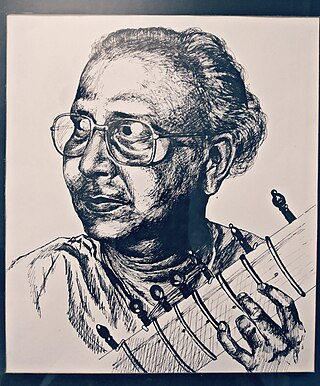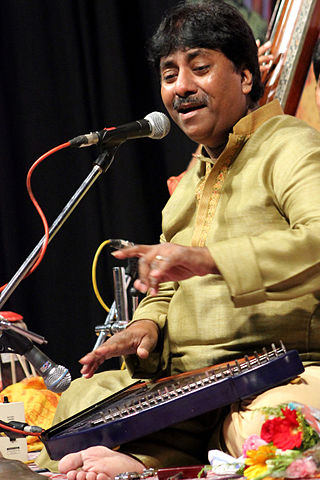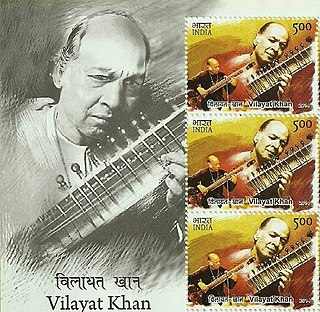Related Research Articles

Surbahar sometimes known as bass sitar, is a plucked string instrument used in the Hindustani classical music of the Indian subcontinent. It is closely related to the sitar, but has a lower pitch. Depending on the instrument's size, it is usually pitched two to five whole steps below the standard sitar.

Ustad Amir Khan was one of the greatest and most influential Indian vocalists in the Hindustani classical tradition. He was the founder of the Indore gharana.

Pandit Nikhil Ranjan Banerjee was an Indian classical sitarist of the Maihar Gharana. Along with Pandit Ravi Shankar and Ustad Vilayat Khan, he emerged as one of the leading exponents of the sitar. He was a recipient of the Indian civilian honour of the Padma Bhushan.

Ustad Shahid Parvez Khan is an Indian classical sitar maestro from the Imdadkhani gharana. He represents the seventh generation of the Etawah Gharana as its primary exponent. He is praised especially for the vocalistic phrasing and quality of his raga improvisations, known as "Gayaki Ang." This translates to "Singing branch/limb". The sitar legend, Ustad Vilayat Khan resurrected and re-introduced Gayaki Ang as a widely accepted sitar genre in India and abroad, and his nephew, Ustad Shahid Parvez Khan has carried this torch into the present day.
Ustad Enayat Khan also known as Nath Singh was one of India's most influential sitar and surbahar players in the first decades of the 20th century. He was the father of Vilayat Khan, one of the topmost sitariyas of the postwar period.
Ustad Imdad Khan was a sitar and surbahar player. He was the first sitar player ever to be recorded.

The Mewati gharana is a musical apprenticeship tribe of Hindustani classical music. Known for being Pandit Jasraj's musical lineage, the gharana was founded by brothers Utd. Ghagge Nazir Khan and Utd. Wahid Khan (beenkar) of Indore in the late 19th century at the Holkar Court. Members of this gharana have had an active influence in Indian cinema for over half a century.
Imrat Khan was an Indian sitar and surbahar player and composer. He was the younger brother of sitar maestro Ustad Vilayat Khan.

Ustad Rashid Khan is an Indian classical musician in the Hindustani music tradition. He belongs to the Rampur-Sahaswan gharana, and is the great-grandson of gharana founder Inayat Hussain Khan. He is married to Soma Khan.

Shujaat Husain Khan is one of the greatest North Indian musicians and sitar players of his generation. He belongs to the Imdadkhani gharana school of music. He has recorded over 100 albums and was nominated for a Grammy Award for Best World Music Album for his work with the band Ghazal with Iranian musician Kayhan Kalhor. He also sings frequently. His style of sitar playing, known as gayaki ang, is imitative of the subtleties of the human voice.
Bimalendu Mukherjee was an Indian classical sitar player and music teacher.
Anupama Bhagwat is an Indian sitar maestro.
The Etawah gharana is a North Indian school of sitar and surbahar music and named after a small town close to Agra where Imdad Khan (1848–1920) lived. It is also known as Imdadkhani gharana in the honour of its founder, Imdad Khan.
The Agra gharana is a tradition of Hindustani classical vocal music descended from the Nauhar Bani. So far, Nauhar Bani has been traced back to around 1300 AD, during the reign of Emperor Allauddin Khilji of Delhi.
Wahid Khan was an Indian surbahar and sitar player. He was the son of Imdad Khan and belonged to the Imdadkhani gharana or Etawah gharana of classical music.
Mushtaq Ali Khan and was an Indian classical sitar, surbahar player.

Pandit Nayan Ghosh is an Indian Tabla and Sitar maestro. He is a tabla player from the Farrukhabad Gharana.

Ustad Vilayat Khan was an Indian classical sitar player. Along with Imdad Khan, Enayat Khan, and Imrat Khan, he is credited with the creation and development of gayaki ang on the sitar.
Mohammad Sharif Khan known as Ustad Sharif Khan Poonchwaley was a classical player of sitar, vichitra veena and raza been in the hindustani classical music tradition.
Ustad Rafique Khan is an Indian musician and composer who plays the sitar. He belongs to the sixth generation of musicians from the Dharwad Gharana. His father, the late Ustad Abdul Karim Khan was a distinguished sitarist at his time, and his grandfather who was awarded the 'Sitar Ratna', Rahimat Khan was accredited for adding the base octave to the sitar and for modifying the three-string sitar to the seven-string instrument that is common today. Khan is the younger brother of Ustad Bale Khan and Chhote Rahimat Khan and has a twin brother, Shafique Khan, also a sitarist.
References
- ↑ List of Padma Bhushan award recipients (2010–2019)
- ↑ "4 Nov 2018 - Pandit Budhaditya Mukherjee | BIMHUIS, Amsterdam".
- ↑ Lata, Swarn (2013). The Journey of the Sitar in Indian Classical Music : Origin, History, and Playing Styles. ISBN 978-1475947076.
- ↑ "I have never begged anyone for concerts: Pandit Budhaditya Mukherjee | Kolkata News - Times of India". The Times of India .
- ↑ "Pt. Budhaditya Mukherjee, Suddha Kalyan alap (clip 1)". YouTube . Archived from the original on 19 December 2021. Retrieved 8 March 2021.
- ↑ "Pt. Budhaditya Mukherjee-Bihag Razakhani Drut Gat". YouTube . Archived from the original on 19 December 2021.
- ↑ "Aga Khan Museum". Aga Khan Museum. Retrieved 3 November 2020.
- ↑ "Sublime Sitar with Pandit Budhaditya Mukherjee (October 19, 2019)". Aga Khan Museum. Retrieved 3 November 2020.